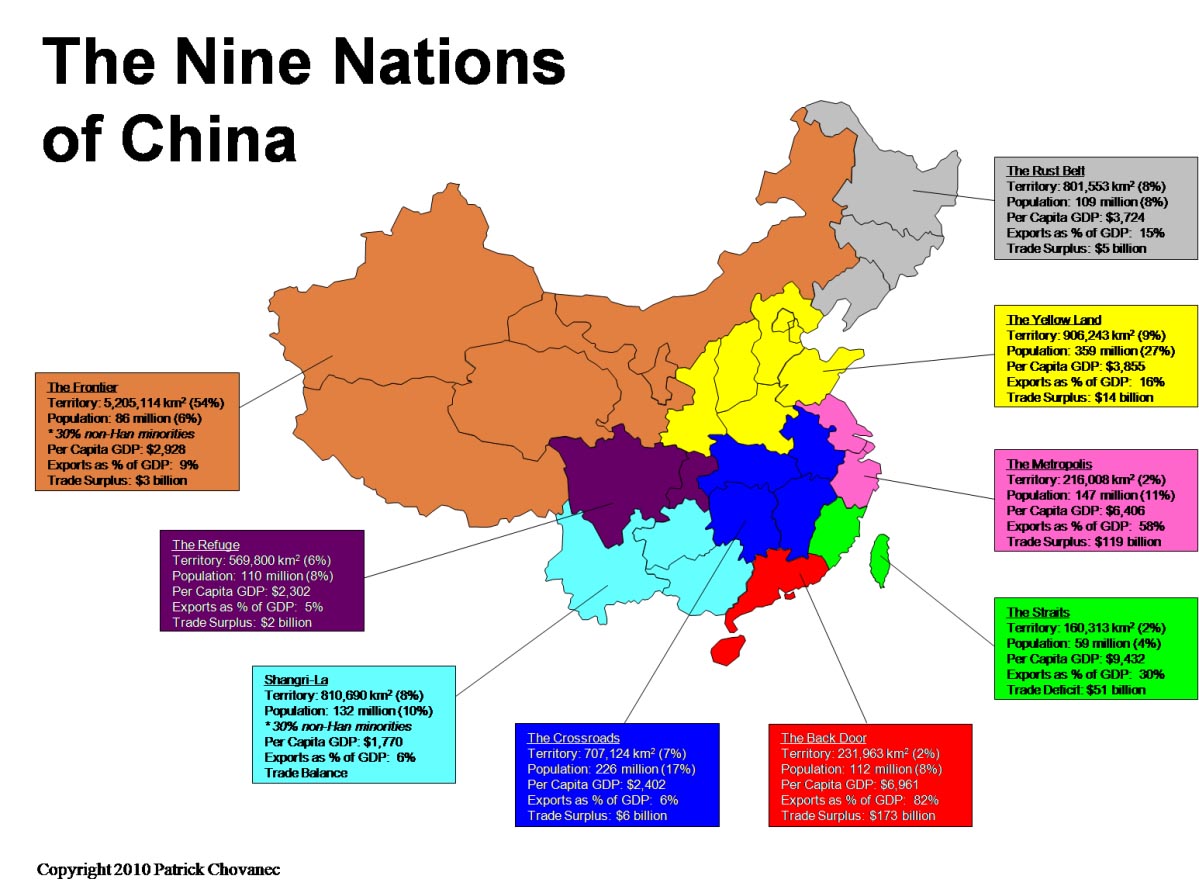In November 2009, The Atlantic published an interactive online feature I authored called “The Nine Nations of China” (九色中国). China often seems like a monolith of 1.3 billion people, but it’s not. It’s a mosaic of distinct regions, and understanding those regions is vital to understanding China.
This article presented a framework for how to think about those regions, what they’re like, and why they matter. The information below (from the original article) is now about a decade out of date, and I plan to update it soon, but the basic outlines it conveys are still highly relevant.

You can find links to descriptions of each of these distinct regions in the chart below. It highlights how, if each of these regions were actually a separate country, they would account for eight of the 20 most populous nations in the world. The smallest would rank between Britain and Italy. That’s pretty astounding, and it illustrates how inadequate it really is to keep painting our image of China with one giant brush.
World’s Largest Nations By Population, 2008
(If China’s Nine Nations Were Broken Out Separately)
| Rank | Country | Population |
| #1 | India | 1,140,566,211 |
| #2 | The Yellow Land | 358,790,000 |
| #3 | United States | 304,059,724 |
| #4 | Indonesia | 237,512,355 |
| #5 | The Crossroads | 226,260,000 |
| #6 | Brazil | 196,342,587 |
| #7 | Pakistan | 171,852,793 |
| #8 | Bangladesh | 154,037,902 |
| #9 | The Metropolis | 146,850,000 |
| #10 | Nigeria | 146,255,306 |
| #11 | Russia | 140,702,094 |
| #12 | Shangri-La | 131,520,000 |
| #13 | Japan | 127,288,419 |
| #14 | The Back Door | 111,510,000 |
| #15 | Mexico | 109,955,400 |
| #16 | The Refuge | 109,770,000 |
| #17 | The Rust Belt | 108,740,000 |
| #18 | Philippines | 96,061,683 |
| #19 | Vietnam | 87,558,363 |
| #20 | The Frontier | 86,320,000 |
| … | ||
| #29 | United Kingdom | 60,943,912 |
| #30 | The Straits | 59,080,000 |
| #31 | Italy | 58,145,321 |
Sources: National Bureau of Statistics of China and U.S. Census Bureau
This is a conceptual framework, not a political statement. Throughout its long history, China has often fragmented along recognizable regional lines, and that has played an important role in its story. But my purpose here is not to predict or advocate the break-up of China into pieces. Rather, it is to offer readers a richer way of seeing China in more than one dimension. The use of the word “nations” (which I translate in Chinese as “colors”) is simply meant to emphasize just how large and distinct each component of China’s mosaic really is.
Videos
Some of my appearances, old and new, talking about China-related topics.
An online talk I gave in 2020 about an old Chinese railroad bond, its impact on China’s history, and its surprising relevance to US-China relations today.
Speaking with CNBC’s Martin Soong about the challenges of investing and doing business in China in the Xi Jinping Era. (June 2022)
A talk I gave to the Chicago Council on Global Affairs in 2018 about the economic challenges China faces going forward.
A talk I gave at New York University in 2014 on the politics of economic reform in China.
A talk I gave at the Woodrow Wilson Center in 2013 on whether China’s economic model is truly superior, or rife with serious problems.
Selected Articles
Some of my previously published articles, blog posts, and other material focused on China.